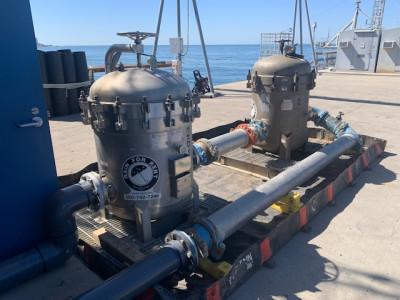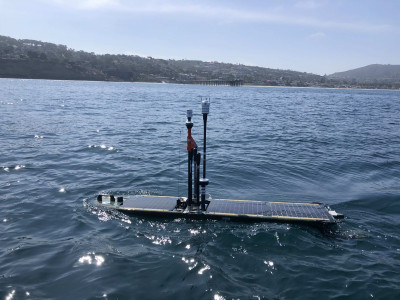University of California San Diego is safeguarding essential campus operations and assisting federal and state agencies in the event leaked oil from a broken pipeline off the coast of Orange County moves south.
Safety officials and oceanographers are working to mitigate impacts on facilities at Scripps Institution of Oceanography and its public exploration center Birch Aquarium that require supplies of clean seawater. Ocean monitoring networks based at Scripps are also providing near-real time updates on wind and ocean currents to oil spill response officials.
Seawater for several Scripps facilities is filtered directly from the Pacific Ocean through an intake system at the end of the Ellen Browning Scripps Memorial Pier. This intake system also supplies seawater to NOAA’s Southwest Fisheries Science Center and a public seawater tap for private and commercial aquaria. The system, which draws about 600,000 gallons of seawater each day, is a critical resource for a marine institution. Environmental concerns like oil spills and harmful red tides threaten research and marine organisms in these aquaria, requiring advanced measures for protection.
To prepare for the introduction of oil into these seawater supplies, UC San Diego’s Environment, Health & Safety (EH&S) office and Facilities Management have established mitigation measures at multiple points within the pier’s seawater water intake network. This includes a temporary filter system adjacent to the pier’s pump house to trap any infiltrating oil.

"We take the integrity of our research facilities, and our public-facing aquarium very seriously, and this oil spill is a threat to that commitment,” said Patrick Callaghan, assistant vice chancellor of finance and operations at Scripps. “Our research community relies upon constant access to seawater to expand our collective knowledge, and Birch Aquarium requires access to seawater to help educate the public about marine life and ecosystems. We appreciate the proactive responses taken by UC San Diego's EH&S and Facilities Management teams to help protect this commitment to our research and educational communities."
UC San Diego is also conducting daily drone surveys. To date, no sheens of oil have been observed near the intake at Scripps or in the waters off La Jolla. If oil is observed in the ocean near Scripps, the incoming seawater will be pumped directly into the pre-filter and final filter unit to remove oil particles and prevent contamination of the overall system.
After the seawater has passed through this filter system, it will be routed to the main system that processes incoming seawater. This system currently has a 60-micron screen that can be modified to trap pollutants as small as 40 microns if needed.
As a third treatment, the university Facilities Management team has installed activated carbon in filter bags along the seawater flume – the channel that transports water the length of the pier. The seawater will pass through this treatment train of activated carbon to remove any non-filterable organics that may infiltrate the system. Before moving to Scripps research labs and Birch Aquarium, the seawater will also pass through a sand filter system located at the base of the pier.
“All the marine plants and animals in Birch Aquarium’s habitats depend on natural seawater drawn from the end of the Scripps Pier,” said Harry Helling, executive director of Birch Aquarium. “Faculty and staff from around the university, along with Birch’s own staff, have done an extraordinary job in preparing an oil spill response that will protect the marine life in our care.”
The oil spill was first reported off the coast of Huntington Beach on Oct. 3, 2021, triggering a response from state and federal agencies. Beaches in northern Orange County closed as oil washed ashore, bringing with it oiled seabirds as it threatened coastal habitats.
“We only see what washes up on the beaches or floats on the surface, so a lot of damage could be done in deep water areas that we can’t see,” said Lisa Levin, a biological oceanographer at Scripps who studies deep ocean and wetland ecosystems. “Oil makes its way into the ecosystem in many different ways. It can be taken up by pelagic fish, fall onto the seafloor, or drift into saltmarshes, adding stress to all those ecosystems.”
Scripps oceanographers and data analysts have been working around the clock with these agencies, including California’s Office of Spill Prevention and Response and NOAA’s Office of Response and Restoration, to monitor ocean conditions around the spill, particularly ocean surface currents, wave and swell forecasts, and wind conditions.
On Oct. 8, a team of Scripps researchers led by oceanographer Sophia Merrifield diverted a wave glider equipped with environmental sensors to the present offshore location of the oil spill. The Boeing-Liquid Robotics wave glider had previously been sampling along a CalCOFI transect, and is now providing wind measurements at the plume location. These data are feeding into forecast models being used by the U.S. Coast Guard and others for cleanup efforts. A second Waveglider was recently deployed that included a hydrocarbon-tuned fluorometer to sample for the absence/presence of oil in the water column. The robot will continue to survey the Southern California waters as far north as Laguna Beach and offshore to Catalina for the next several weeks.

In July 2020, NOAA’s Office of Marine and Aviation Operations and Scripps signed a 10-year agreement to improve how unmanned systems – such as wavegliders – are used to collect important ocean observations and augment NOAA’s operational capabilities.
In addition to the wavegliders, surface current data obtained from high-frequency radar networks provide hourly maps of ocean surface currents in near-real time. The Southern California Coastal Ocean Observing System (SCCOOS) operates a network of these stations, providing information to agencies overseeing response efforts.
“The ocean currents in Southern California are notoriously difficult to forecast due to the presence of islands and complex coastal topography,” said Eric Terrill who led the installation of this radar network close to 20 years ago and is now Director of the Scripps Marine Physical Laboratory. “This complexity puts a premium on the need for real-time observations to inform oil spill response strategies.”
Reports of oil tar balls washing ashore, including at beaches near the Scripps campus in La Jolla, have been reported. A Shoreline Cleanup and Assessment Technique (SCAT) team managed by the spill’s Unified Command is monitoring local shorelines. Researchers are testing the chemical makeup of these tar balls to determine whether they are from the spill or among the shoreline deposits occasionally produced by offshore seeps.
Water samples are being collected from the end of Scripps Pier to be analyzed for diesel range organics, which are signature components of crude oil. Currently the samples are being analyzed by a commercial lab, however, Neal Arakawa of UC San Diego’s Environmental and Complex Analysis Laboratory and Scripps Oceanography chemical oceanographer Lihini Aluwihare are setting up an in-house lab to analyze water samples for petroleum hydrocarbons. In addition, the County of San Diego Emergency Operations Center has included three sampling locations at Scripps for water quality monitoring. As of Oct. 13, 2021, no petroleum chemicals have been detected in water samples.
More information on the oil spill response can be found at www.socalspillresponse.com, which is managed by the U.S. Coast Guard, the lead agency coordinating the response. Additionally, if members of the public encounter tarballs on the beaches, for safety reasons, it is not recommended to handle tarballs nor any oil, but to contact clean up teams via tarballreports@wildlife.ca.gov to inform them of locations.
About Scripps Oceanography
Scripps Institution of Oceanography at the University of California San Diego is one of the world’s most important centers for global earth science research and education. In its second century of discovery, Scripps scientists work to understand and protect the planet, and investigate our oceans, Earth, and atmosphere to find solutions to our greatest environmental challenges. Scripps offers unparalleled education and training for the next generation of scientific and environmental leaders through its undergraduate, master’s and doctoral programs. The institution also operates a fleet of four oceanographic research vessels, and is home to Birch Aquarium at Scripps, the public exploration center that welcomes 500,000 visitors each year.



